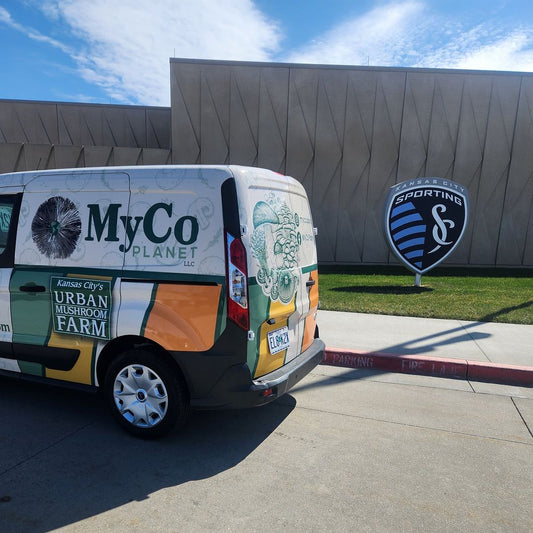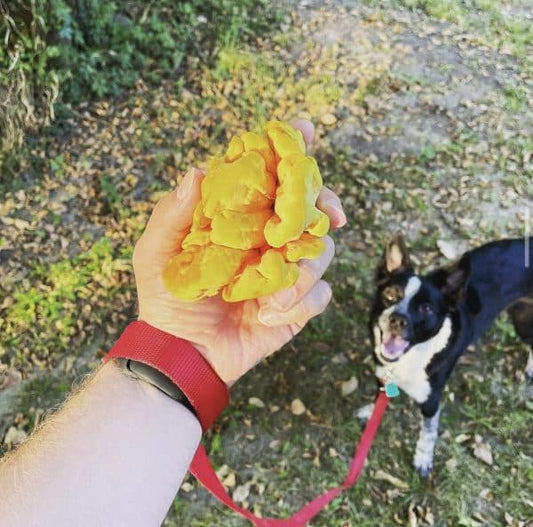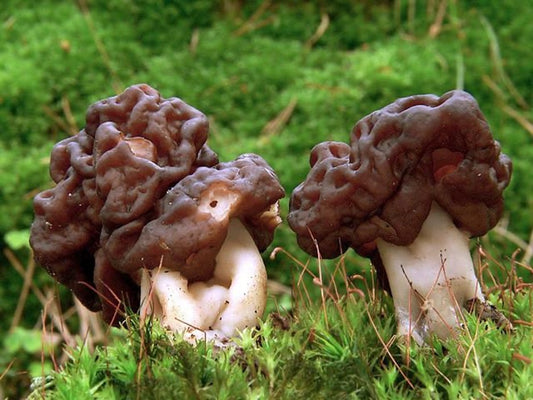Making a mushroom spore print and spore syringe is relatively easy, but ensuring as little contamination as possible from outside sources makes the process a little bit more complicated. While it is not completely necessary to perform your work in a sterilized environment, it does improve the probability that your spore print won’t contain other spores or bacteria that may end up contaminating your culture.
How to make a mushroom spore print and spore syringe?
Making a mushroom spore print and spore syringe is as simple as placing a mushroom cap with the gill side down on a sheet of aluminum foil, covering it with a bowl, and waiting for about 24 hours for the spores to drop onto the surface below. Then, to make a spore syringe, scrape the spore print into a glass with sterilized water and pull the solution into a syringe.
After you have created a spore print, you can save it for later use, make a spore syringe, apply it to an agar solution or create a liquid culture. We will discuss each option a bit more below.
If you want to know how to make a mushroom spore print and spore syringe in exact detail, with sterile techniques, follow the steps below.
Start with the best genetics by searching for the ideal mushroom you are currently growing. When you have spotted the ideal specimen, put on a pair of nitrile or latex gloves and sterilize them with 70%+ alcohol. Harvest the mushroom.
Immediately after harvesting this mushroom, cut off the cap from the stem with a flame-sterilized X-Acto knife or scissors. Then, use sterilized tweezers to transfer the mushroom cap with the gill side down onto a sterilized piece of wax or parchment paper or a flame-sterilized sheet of aluminum foil. For the best results, perform this entire process in a sterilized box.
While it may seem extreme, performing sterile techniques limits the possibility of contamination.
Now, use a pipette and drop a couple of drops of sterilized water onto the mushroom cap. This will simulate nature, as mushrooms generally drop their spores after rainfall to increase the probability of reproduction. Finally, cover the mushroom cap with a glass bowl and allow it to sit for 24 hours.
Behold Your Spores
Upon coming back to your workstation, remove the glass bowl, and remove the mushroom cap with sterilized tweezers. Below it, on the aluminum foil, you should see a defined spore print that will be the starting point for growing another batch of mushrooms.
Saving A Spore Print For A Later Date
Spores can be saved for quite a while, generally, at least 5 years, if stored in a relatively cool, dark area. Fold up the piece of paper or aluminum foil around the spore print and save it in a Ziplock bag with an optional silica gel packet to reduce moisture. Then, store the Ziplock bag in a place where you won’t forget it, like a book. Better yet, save the spore print in the refrigerator, or the freezer, as this will increase its viability long-term. If saved in the freezer, spores have been known to be viable for as long as 10 years.
Making A Spore Syringe From A Spore Print
Making A Sterilized Glove Box
Making and using a sterilized glove box will significantly reduce the probability of contamination. A sterile box doesn’t require much of an investment and can be built with a simple plastic tub and cover.
After securing a transparent plastic tub that has a snap-on cover, purchase a pair of heavy-duty kitchen gloves, a can of Lysol, 70%+ alcohol, and duct tape. On one of the long sides of the plastic bin, cut out two holes that are big enough to fit your hands in comfortably.
One of the best ways to drill out these holes is to use a door handle drill attachment and then drill into the side of the bin while holding a piece of wood on the other side to avoid cracking the plastic. While this drill bit may not be big enough to cut the holes of the size you desire, they give you a good starting point and you can continue to cut out the holes as big as you want with an X-Acto knife.
After sanding down the holes you just cut out, duct tape the heavy-duty kitchen gloves to the holes so that no air can enter the plastic bin. This will allow you to work inside the bin without introducing contamination. Make sure the gloves are long enough so you can work comfortably inside the bin.

What Do You Need To Make A Spore Syringe
To make a spore syringe, you are going to need distilled water, a glass, used or brand-new syringes, metal utensils, and a pressure cooker.
First, fill the shot glass or regular-sized glass with distilled water, using a little bit more water than what you will need to fill up all your spore syringes. Now, cover that glass with aluminum foil and place it in the pressure cooker.
At this point, place aluminum foil over all other items you want to sterilize, including the syringes that you want to reuse again, in the pressure cooker. After pressure cooking the equipment for at least 15 minutes, let it cool down.
Preparing The Sterile Box Before Making A Spore Print And Spore Syringe
When you are ready to make a mushroom spore print and spore syringe, wipe down the inside of the sterile box and the rubber gloves with alcohol, and then spray the inside of the box with Lysol. Now, move the equipment you need to make a spore print and spore syringe inside the sterile box and snap on the cover. You now have a sterilized air box that has everything you need for both steps, meaning you won’t have to open up the box at any time and introduce contamination.
If you are first making a spore print inside the sterile box, do so, and come back in a day to make the spore syringe. If you already have the spore print ready to go, you are ready to make a spore syringe now.
Making A Spore Syringe In A Sterilized Environment
All of the sterilized equipment should be ready to go inside the sterile box. Reach your hands into the rubber gloves and scrape the spore print into the sterilized, distilled water. Mix it up a bit with a sterilized instrument or use the syringe to mix up the water by pulling a small amount in and pushing it back out repeatedly. Then, pull in the syringe, fill it completely with spore solution, and cap it off. Now, you have a spore syringe that you can use right away or save for another time.

Adding Spores To An Agar Solution
After making an agar solution and adding it to a petri dish, add the spores to the agar. This can be done by squirting a small amount of spore solution from the spore syringe or by transferring the spores directly from the print with a sterilized instrument. Within a short while, you will notice mycelium growing on the agar solution and you can use this to inoculate your substrate.
Making a Mycelium Liquid Culture
You can also use your spores to make a mycelium liquid culture that can be used to inoculate the substrate. The advantage of using a mycelium liquid culture to inoculate your substrate is that it grows faster, as it has already grown past the spore stage.
In a Mason jar, mix a 25-to-1 ratio of distilled water and light corn syrup. For instance, mix 100 ml of warm, distilled water, with 4 ml of light corn syrup. In the cover of the Mason jar, poke a hole big enough for the syringe needle to enter and cover it with breathable tape. Using light corn syrup is a cheap replacement for agar and it works just as well for growing mycelium. Also, add either a marble or a magnetic stir bar to the jar.
Now, sterilize the solution in a pressure cooker. After the sugar solution has cooled down to room temperature, add the spores. The best way to do this is to take the cap off the spore syringe and flame-sterilize the needle. Then, take an alcohol swab and douse the needle. This does two things, it further sterilizes the needle and quickly reduces the temperature of the needle after the flame-sterilization. Now, rub alcohol onto the pre-injection area, inject the needle into the breathable tape and inject a small amount of spore solution. Quickly cover the hole left over by the needle with another piece of breathable tape.
Going forward, either shake up this solution from time to time using the marble to mix the mycelium or place it on a magnetic stirrer, if it has a magnetic stir bar. Anytime you want to use this mycelium liquid culture, you can easily add it to the substrate you want to inoculate. As stated before, growing mushrooms from mycelium instead of spores shave off a number of days, greatly increasing efficiency.
Making An Alcohol Lamp For Easy Flame-Sterilization
If you are only sterilizing a few different items from time to time, a lighter works just fine, but as soon as you start constantly sterilizing items you are going to want a better method. Typically, an alcohol lamp is the easiest way to flame sterilize items, as it is simple to build and efficient to operate.
To make an alcohol lamp for flame sterilization, get a Mason jar and poke a hole in the cover. Now, take either a cotton ball and elongate it or use a piece of cotton from an old t-shirt and make sure that it stretches from the bottom of the jar all the way up through the hole. This is going to absorb alcohol and serve as the wick.
Now, fill the Mason jar with 70%+ alcohol and allow the wick to completely saturate in the flammable liquid. At this point, light the wick of the alcohol lamp and notice how clean it burns and how little alcohol it actually uses when left on for long durations of time.
Anytime you are flame sterilizing items, it is easy to just light the alcohol lamp, use it as desired, and blow it out.
What Do I Do If My Spores Are Contaminated?
If your spores are contaminated, you will quickly know, as you inoculate substrate and various other organisms start to replicate. There are a few solutions to get back to a clean slate and possess a spore syringe with only the species of spores you intend to cultivate.
First, you can buy a new spore syringe from a supplier. Second, you can do what microbiologists do by swiping a tiny amount of spore solution onto an agar plate, letting it grow, and removing the mycelium that appears to be uncontaminated. Then, transfer that mycelium to another new agar plate, continuing to do so until only mycelium from the specific species you want to cultivate is present.
At this point, transfer this healthy mycelium into the substrate you want to inoculate. As soon as mushrooms have grown from this new batch, make a new spore print and spore syringe, following all the sterile techniques described above and you should have an uncontaminated spore syringe.
How To Make A Mushroom Spore Print And Spore Syringe
Now that you know how to make a mushroom spore print and spore syringe, you don’t need to buy spores again and can consistently produce crop after crop of mushrooms.
To get started on your journey, you can buy oyster grow kits from us that make it easy to go from spore to harvesting mushrooms without having to be a Mycology expert.



